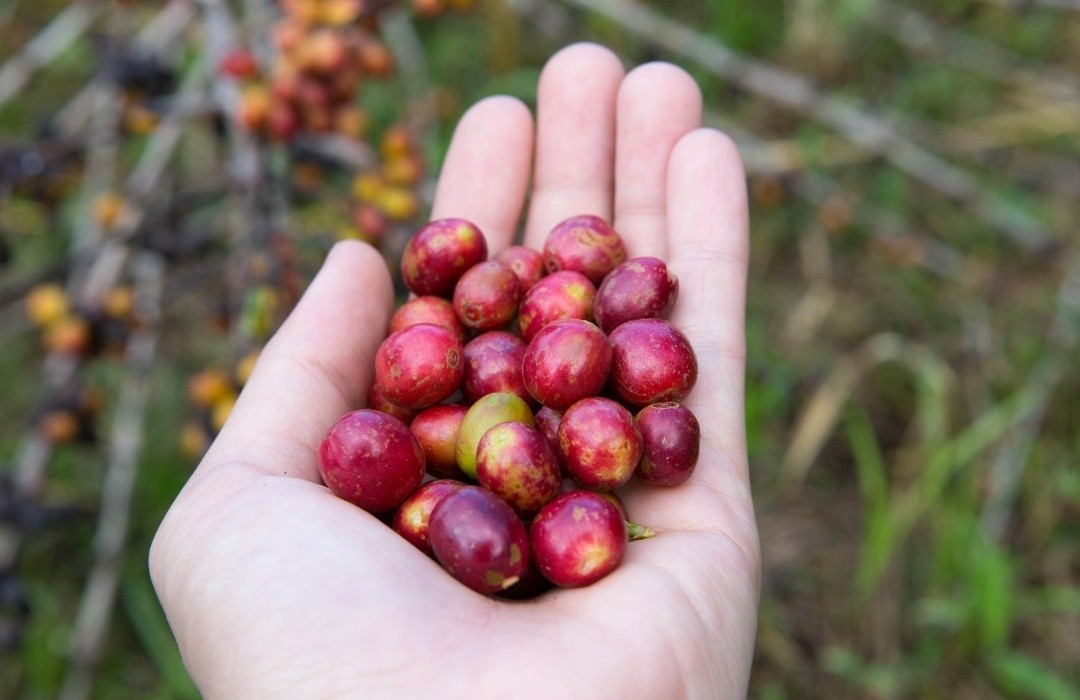
The life cycle of a coffee bean is a seriously intricate one, filled with all types of processes that culminate to create the delicious brew that ends up in your cup. And what better way to find out about it than by coming on the journey of a coffee bean with us! Here’s the entire coffee process from tree to cup.
GROWING
Coffee begins it’s humble life as a delicate shrub and battles with the natural elements until, tada, a few years later (three to be exact) becomes a tree. Coffee trees can grow up to ten metres tall and produce a helluva lot of beans. It’s within the three years that the coffee tree begins growing its fruit, also known as cherries. The first few seasons start with a small amount of cherries, not enough to bother with harvesting. But then, after another three years (are you keeping up? That’s a massive six years later!), there will finally be enough cherries for the season that are ready to harvest.
Around 2 to 4 kilos of cherries are produced by each tree, each season, and ripen into a deep red colour before it’s time to pick. Each tree can be picked up to five times throughout it’s lifespan, so never fear that your coffee supply will run out!
PICKING
You’ll mostly find these little babies being picked by hand, with some larger coffee farms using mechanical pickers to lighten the load. Hand picked coffee is, of course, the best because experienced coffee pickers know what the perfect coffee beans look, smell and feel like.
However, even when picked by mechanical helpers, the coffee cherries still undergo the same process of sorting. The cherries must tick boxes based on size, ripeness and density to make the cut. Only the ripest berries make it to the next stage of the coffee lifecycle.
PROCESSING
There are two types of processing methods for coffee beans, wet and dry.
With wet processing, the coffee ‘pulp’ is separated from the cherry prior to drying by undergoing a bathing stage. This is a pretty nifty way to determine if any unripe cherries have made it through to this stage of the lifecycle as they will float to the top. Wet processing is a popular method in Papua New Guinea and is ideal when looking to reduce acidity levels.
Drying is a more popular method in areas where rainfall is limited because the processing method used depends largely on the climate and conditions of the area it is produced in. Places like Ethiopia, Brazil, Costa Rica and Colombia are known for using the dry processing technique. This makes for a sweeter tasting coffee.
FILTERING
There are so many different filtering techniques and these each impact the taste of the coffee in a huge way. During the filtering process, some coffee beans are kept in a ventilated environment for 1 to 6 years to further reduce the coffee’s acidity. That’s a long time to be cooped up for, but trust us - It pays off.
Another filtering process faced by some less fortunate coffee beans in Indonesia is one where the really unlucky coffee beans are met with the Asian Palm Civet (or Toddy Cat) who eats the coffee and, well, you know the rest. These beans then become some of the most expensive in the world! Yep, can you believe it? This type of coffee is called Kopi Luwak and it can cost upwards of fifty bucks a pop for a single shot of the stuff!
HULLING
Removing the coffee shell from the bean is a long process which can either be done by hand, a machine, or, you know, an Asian Palm Civet sometimes.
POLISHING
A rare luxury across coffee beans is the polishing process. To make the coffee beans look a million bucks (because while looks aren’t everything, it sure does make us want coffee more when it’s pretty!), they are polished. The beans are then shipped away for...
ROASTING
Roasting is really where the magic happens. This is where the most delicious flavours and aromas are unlocked while the sugars within the coffee beans caramelise. And not to toot our own horn or anything, but it’s considered a bit of an art! Timing is of the essence when it comes to roasting and there really is such a difference between old beans and drinking the freshest beans of all (btw we roast to order daily) when seeking out that rich, deliciously smooth coffee.
The life cycle of a coffee bean from tree to cup is a long one. Savour your next cuppas' taste with its' story in mind!